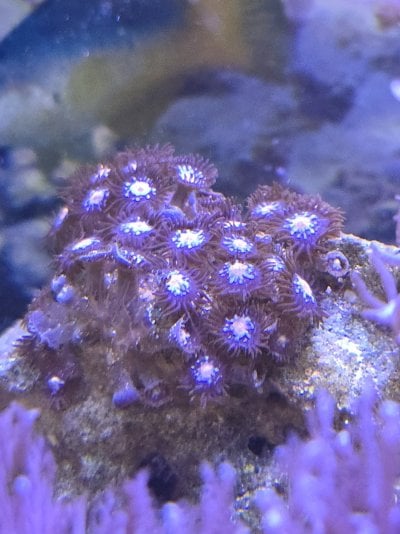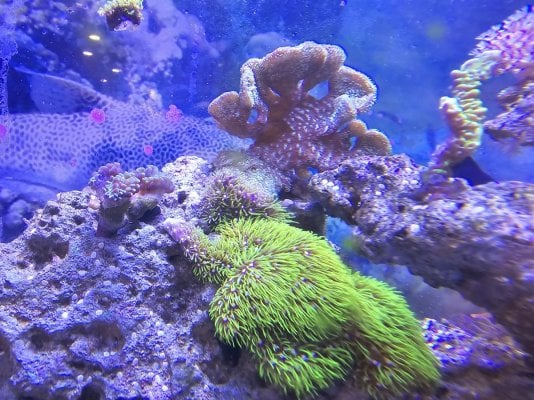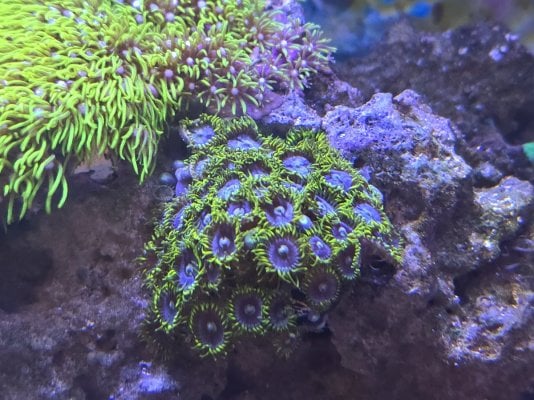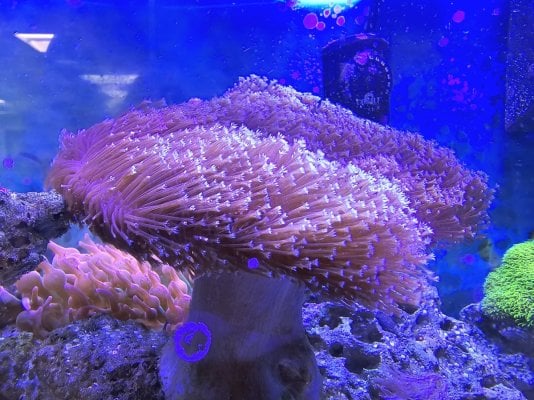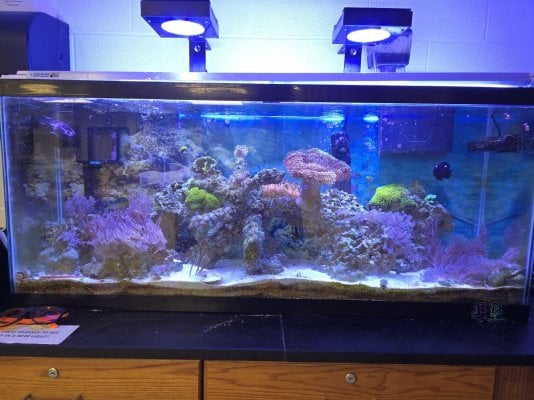Hey everyone!
So I never officially created a build thread for my school tank, but with the end of the school year fast approaching, I wanted to share what my students and I have created.
The journey technically started last school year when I added a green spotted puffer and some Columbian sharks to my 55-gallon tank in my classroom. I've had a few different tanks here before, starting with a small community tank, a 55 gallon African Cichlid tank (which I was forced to bring home during the COVID shutdown of 2020), and a tank with local pond organisms, but I needed something that would make an impression. Fast forward a year and these three began their transition from freshwater to brackish to full-marine conditions. I finally reached marine salinity values in December 2023, which is when the first photo was taken. It was at this point that I decided to make the jump to a reef tank, since I already had the salt water.

A little more on that decision...I am primarily a chemistry teacher, but this school year, I had the opportunity to teach an Environmental Science class for the first time. I wanted this class to be filled with real experiences, both inside and out, to make the class more enjoyable. I had the idea of creating a coral reef in the classroom so that the students could feel connected with some of the environmental issues that coral reefs are experiencing today. I wanted them to see how corals lived, I wanted them to see how fish and invertebrates interacted with each other, live corals, and the reef skeleton. So I went for it. I purchased some live rock, a clean-up crew and marine fish and began the journey.
It was a pretty slow process from that point. There were no funds available from the school, and my budget for a school tank was very small, especially with a new baby on the way. I found some good deals and got a lot of donations. Bulk Reef Supply donated a RO/DI system, Cobalt Aquatics donated a heater, and a local company donated a HOB skimmer to us. I was also able to receive a donation of my first live corals from our local aquarium! It was finally starting to look like a reef.
Fast forward to today, and here is what the tank looks like today: (sadly, our catfish got too large and had to be rehomed, but the puffer is still thriving)

No option for a sump, at least as of now, so it is running with a Seachem Tidal 110 HOB with a Bubble Magus HOB skimmer. I have a Maxspect gyre on one end with a smaller powerhead on the other. The lighting is a combination of a simple T5 bulb with 2 Nicrew HyperReef lights (not the strongest, I know, but we are getting some decent growth despite being on a budget).
Even better is the amount that my students have learned using the tank in the classroom. We have created a flip chart of all the organisms in the tank, have done weekly water parameter tests, discussed the importance of water changes and worked on properly doing them, plus the amount of class material we have been able to apply to what is inside the tank. We even got the opportunity to take a trip to our aquarium and learn about reefs in nature and how they are helping to preserve them. These experiences alone are worth all the time and effort it took to setup and maintain this system.
So that is where we are at now! Someday, I would love to be able to afford some stronger lights and some higher-end corals. But this is where it will be for now.
I know it isn't much, and it certainly isn't perfect, but it makes me happy I come in to work every day excited to check it out. I love being able to teach about it (and learn myself) and incorporate it into my lessons. I find that I prefer watching the tank or doing maintenance on it than grading papers. It is one of my favorite things about this school year.
I come in to work every day excited to check it out. I love being able to teach about it (and learn myself) and incorporate it into my lessons. I find that I prefer watching the tank or doing maintenance on it than grading papers. It is one of my favorite things about this school year.
Anyway, that is how it all came together for us. Like I said, it may not be the best system, but its ours. Hope you've enjoyed reading about our journey!
So I never officially created a build thread for my school tank, but with the end of the school year fast approaching, I wanted to share what my students and I have created.
The journey technically started last school year when I added a green spotted puffer and some Columbian sharks to my 55-gallon tank in my classroom. I've had a few different tanks here before, starting with a small community tank, a 55 gallon African Cichlid tank (which I was forced to bring home during the COVID shutdown of 2020), and a tank with local pond organisms, but I needed something that would make an impression. Fast forward a year and these three began their transition from freshwater to brackish to full-marine conditions. I finally reached marine salinity values in December 2023, which is when the first photo was taken. It was at this point that I decided to make the jump to a reef tank, since I already had the salt water.
A little more on that decision...I am primarily a chemistry teacher, but this school year, I had the opportunity to teach an Environmental Science class for the first time. I wanted this class to be filled with real experiences, both inside and out, to make the class more enjoyable. I had the idea of creating a coral reef in the classroom so that the students could feel connected with some of the environmental issues that coral reefs are experiencing today. I wanted them to see how corals lived, I wanted them to see how fish and invertebrates interacted with each other, live corals, and the reef skeleton. So I went for it. I purchased some live rock, a clean-up crew and marine fish and began the journey.
It was a pretty slow process from that point. There were no funds available from the school, and my budget for a school tank was very small, especially with a new baby on the way. I found some good deals and got a lot of donations. Bulk Reef Supply donated a RO/DI system, Cobalt Aquatics donated a heater, and a local company donated a HOB skimmer to us. I was also able to receive a donation of my first live corals from our local aquarium! It was finally starting to look like a reef.
Fast forward to today, and here is what the tank looks like today: (sadly, our catfish got too large and had to be rehomed, but the puffer is still thriving)
No option for a sump, at least as of now, so it is running with a Seachem Tidal 110 HOB with a Bubble Magus HOB skimmer. I have a Maxspect gyre on one end with a smaller powerhead on the other. The lighting is a combination of a simple T5 bulb with 2 Nicrew HyperReef lights (not the strongest, I know, but we are getting some decent growth despite being on a budget).
Even better is the amount that my students have learned using the tank in the classroom. We have created a flip chart of all the organisms in the tank, have done weekly water parameter tests, discussed the importance of water changes and worked on properly doing them, plus the amount of class material we have been able to apply to what is inside the tank. We even got the opportunity to take a trip to our aquarium and learn about reefs in nature and how they are helping to preserve them. These experiences alone are worth all the time and effort it took to setup and maintain this system.
So that is where we are at now! Someday, I would love to be able to afford some stronger lights and some higher-end corals. But this is where it will be for now.
I know it isn't much, and it certainly isn't perfect, but it makes me happy
Anyway, that is how it all came together for us. Like I said, it may not be the best system, but its ours. Hope you've enjoyed reading about our journey!






